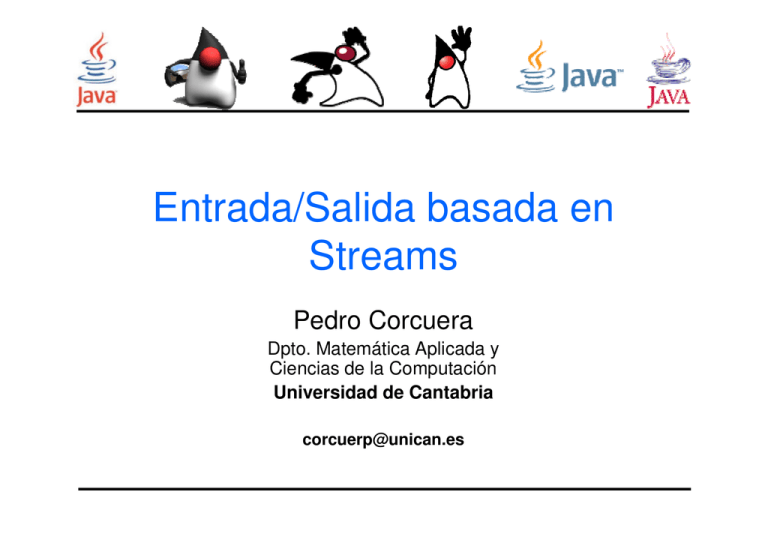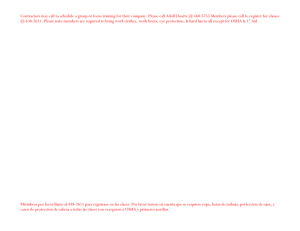Entrada/Salida basada en Streams
Anuncio

Entrada/Salida basada en Streams Pedro Corcuera Dpto. Matemática Aplicada y Ciencias de la Computación Universidad de Cantabria [email protected] Objetivos • Estudiar las clases de Entrada/Salida basadas en Streams • Comprender las clases y métodos disponibles para lectura/escritura de ficheros binarios y texto Java 2 Índice • • • • • • • • • Qué es una entrada/salida stream Tipos de Streams Jerarquía de clases Stream Flujo de control de una operación E/S usando Streams Byte – Character – Buffered streams Standard streams Data streams Object streams File class Java 3 Streams de Entrada/Salida (I/O) • Un Stream I/O representa una fuente de entrada o un destino de salida • Un stream puede representar varios tipos diferentes de fuentes y destinos: – ficheros en disco, dispositivos, otros programas, un socket de red y arrays de memoria • Los streams soportan varios tipos de datos – bytes simples, tipos de datos primitivos, caracteres localizados, y objetos • Algunos streams son de paso y otros de conversión Java 4 Streams de Entrada/Salida (I/O) • Sin importar cómo trabajan internamente, todos los streams presentan el mismo modelo simple a los programas que los usan – Un stream es una secuencia de bytes • La entrada/salida basada en streams soprta la lectura o escritura de datos secuencialmente • Un stream se puede abrir para leer o escribir, pero no la leer y escribir Java 5 Stream de Entrada (Input Stream) – Un programa usa un input stream para leer datos de una fuente, uno a la vez (secuencialmente) – Un programa usa un output stream para escribir datos a un destino, uno a la vez (secuencialmente) Java 6 Tipos de Streams generales • Byte y Character Streams – Character vs. Byte • Input y Output Streams – Basados en fuente o destino • Node y Filter Streams – Si los datos en un stream son o no manipulados o transformados Java 7 Streams Byte y Character • Byte streams – Para datos binarios – Clases raíz de byte streams (ambas son abstractas): • Clase InputStream • Clase OutputStream • Character streams – Para caracteres Unicode – Clases raíz de character streams (ambas abstractas): • Clase Reader • Clase Writer Java 8 Streams Input y Output • Input o source streams – Pueden leer de estos streams – Clases raíz de todos los input streams: • Clase InputStream • Clase Reader • Output o sink (destino) streams – Pueden escribir en estos streams – Clases raíz de todos los output streams: • Clase OutputStream • Clase Writer Java 9 Streams Nodo y Filtro • Node streams (sumidero de datos) – Contienen la funcionalidad básica de lectura o escritura de una ubicación específica – Los tipos de nodo streams incluyen ficheros, memoria y pipes • Filter streams (stream de procesado) – Capa sobre los streams nodo entre hilos de ejecución o procesos – Para una funcionalidad adicional – alterando o gestionando datos en el stream Java 10 Jerarquía de la clase Stream Java 11 Clases Abstractas • InputStream y OutputStream • Reader y Writer Java 12 Clase Abstracta InputStream Method Summary int available() Returns the number of bytes that can be read (or skipped over) from this input stream without blocking by the next caller of a method for this input stream. void close() Closes this input stream and releases any system resources associated with the stream. void mark(int readlimit) Marks the current position in this input stream. boolean markSupported() Tests if this input stream supports the mark and reset methods. abstract int read() Reads the next byte of data from the input stream. int read(byte[] b) Reads some number of bytes from the input stream and stores them into the buffer array b. int read(byte[] b, int off, int len) Reads up to len bytes of data from the input stream into an array of bytes. void reset() Repositions this stream to the position at the time the mark method was last called on this input stream. long skip(long n) Skips over and discards n bytes of data from this input stream. Java 13 Clases InputStream Nodo Clases InputStream Nodo FileInputStream A FileInputStream obtains input bytes from a file in a file system. PipedInputStream A piped input stream should be connected to a piped output stream; the piped input stream then provides whatever data bytes are written to the piped output stream. Java 14 Clases InputStream Filtro Clases InputStream Filtro BufferedInputStream adds functionality to another input stream-namely, the ability to buffer the input and to support the mark and reset methods. FilterInputStream contains some other input stream, which it uses as its basic source of data, possibly transforming the data along the way or providing additional functionality. ObjectInputStream deserializes primitive data and objects previously written using an ObjectOutputStream. DataInputStream lets an application read primitive Java data types from an underlying input stream in a machine-independent way PushbackInputStream adds functionality to another input stream, namely the ability to "push back" or "unread" one byte Java 15 Clase Abstracta OutputStream Method Summary void close() Closes this output stream and releases any system resources associated with this stream. void flush() Flushes this output stream and forces any buffered output bytes to be written out. void write(byte[] b) Writes b.length bytes from the specified byte array to this output stream. void write(byte[] b, int off, int len) Writes len bytes from the specified byte array starting at offset off to this output stream. abstract void write(int b) Writes the specified byte to this output stream. Java 16 Clases OutputStream Nodo Clases OutputStream Nodo FileOutputStream A file output stream is an output stream for writing data to a File or to a FileDescriptor PipedOutputStream A piped output stream can be connected to a piped input stream to create a communications pipe Java 17 Clases OutputStream Filtro Clases OutputStream Filtro BufferedOutputStream the class implements a buffered output stream FilterOutputStream is an output stream for writing data to a File or to a FileDescriptor ObjectOutputStream writes primitive data types and graphs of Java objects to an OutputStream DataOutputStream lets an application write primitive Java data types to an output stream in a portable way PrintStream adds functionality to another output stream, namely the ability to print representations of various data values conveniently Java 18 Clase Reader: Métodos Reader Methods abstract void close() Closes the stream and releases any system resources associated with it. void mark(int readAheadLimit) Marks the present position in the stream. boolean markSupported() Tells whether this stream supports the mark() operation. int read() Reads a single character. int read(char[] cbuf) Reads characters into an array. abstract int read(char[] cbuf, int off, int len) Reads characters into a portion of an array. int read(CharBuffer target) Attempts to read characters into the specified character buffer. boolean ready() Tells whether this stream is ready to be read. void reset() Resets the stream. long skip(long n) Skips characters. Java 19 Clases Reader Nodo Clases Reader Nodo FileReader Convenience class for reading character files CharArrayReader This class implements a character buffer that can be used as a character-input stream StringReader A character stream whose source is a string PipedReader Piped character-input streams Java 20 Clases Reader Filter Clases Reader Filter BufferedReader Reads text from a character-input stream, buffering characters so as to provide for the efficient reading of characters, arrays, and lines FilterReader Abstract class for reading filtered character streams InputStreamReader An InputStreamReader is a bridge from byte streams to character streams: It reads bytes and decodes them into characters using a specified charset LineNumberReader A buffered character-input stream that keeps track of line numbers PushbackReader A character-stream reader that allows characters to be pushed back into the stream Java 21 Clase Writer: Métodos Writer Methods Writer append(char c) Appends the specified character to this writer. Writer append(CharSequence csq) Appends the specified character sequence to this writer. Writer append(CharSequence csq, int start, int end) Appends a subsequence of the specified character sequence to this writer. abstract void close() Closes the stream, flushing it first. abstract void flush() Flushes the stream. void write(char[] cbuf) Writes an array of characters. abstract void write(char[] cbuf, int off, int len) Writes a portion of an array of characters. void write(int c) Writes a single character. void write(String str) Writes a string. void write(String str, int off, int len) Writes a portion of a string. Java 22 Clases Writer Nodo Clases Writer Nodo FileWriter Convenience class for writing character files CharArrayWriter This class implements a character buffer that can be used as an writer StringWriter A character stream that collects its output in a string buffer, which can then be used to construct a string PipedWriter Prints formatted representations of objects to a text-output stream Java 23 Clases Writer Filtro Clases Writer Filtro BufferedWriter Writes text to a character-output stream, buffering characters so as to provide for the efficient writing of single characters, arrays, and strings FilterWriter Abstract class for writing filtered character streams OutputStreamWriter An OutputStreamWriter is a bridge from character streams to byte streams: Characters written to it are encoded into bytes using a specified charset PrintWriter Prints formatted representations of objects to a text-output stream Java 24 Control del flujo de una operación I/O Crear un objeto stream y asociarlo con la fuente de datos Dar al objeto stream la funcionalidad deseada a través del encadenamiento del stream while (hay más información) leer (escribir) siguiente dato desde (a) el stream cerrar el stream Java 25 Byte Stream • Los programas usan byte streams para realizar input y output de bytes (8-bit) • Todas las clases byte stream descienden de InputStream y OutputStream • Hay varias clases byte stream – FileInputStream y FileOutputStream • Se usan de forma similar; la diferencia es la forma en que se construyen • Se deben usar en I/O primitivo o de bajo nivel Java 26 Ejemplo: FileInputStream y FileOutputStream public class CopyBytes { public static void main(String[] args) throws IOException { FileInputStream in = null; FileOutputStream out = null; try { in = new FileInputStream("prueba.txt"); out = new FileOutputStream("byteprueba.txt"); int c; while ((c = in.read()) != -1) { out.write(c); } } finally { if (in != null) { in.close(); } if (out != null) { out.close(); } } } } Java 27 Character Stream • Java utiliza el código Unicode para los caracteres • La I/O character stream convierte automáticamente este formato interno a y del conjunto de caracteres locales • Todas las clases character stream descienden de Reader y Writer • Como en los byte streams, hay clases character stream que se especializan en I/O de ficheros: FileReader y FileWriter Java 28 Ejemplo: FileReader y FileWriter public class CopyCharacters { public static void main(String[] args) throws IOException { FileReader inputStream = null; FileWriter outputStream = null; try { inputStream = new FileReader("prueba.txt"); outputStream = new FileWriter("characteroutput.txt"); int c; while ((c = inputStream.read()) != -1) { outputStream.write(c); } } finally { if ((inputStream != null) {inputStream.close(); } if (outputStream != null) { outputStream.close(); } } } } Java 29 Buffered Streams • Un unbuffered I/O significa que cada solicitud de lectura o escritura es gestionado directamente por el sistema operativo subyacente (ineficiente) • Para reducir esta sobrecarga, Java implementa los buffered I/O streams – Con los buffered input streams se leen datos desde un area de memoria conocida como buffer; la API nativa se invoca sólo cuando el buffer está vacío – Para los buffered output streams la API se invoca cuando el buffre está lleno Java 30 Creación de Buffered Streams • Un programa puede convertir un unbuffered stream en un buffered stream usando envolventes. Ejemplo: inputStream = new BufferedReader(new FileReader("prueba.txt")); outputStream = new BufferedWriter(new FileWriter("charoutput.txt")); • Las clases buffered stream son: – BufferedInputStream y BufferedOutputStream crean buffered byte streams – BufferedReader and BufferedWriter crean buffered character streams Java 31 Ejemplo: escribe matriz con BufferedOutputStream import java.io.*; public class EscribeMatrizBufOutSt { static double[][] data = { { Math.exp(2.0), Math.exp(3.0), Math.exp(4.0) }, { Math.exp(-2.0), Math.exp(-3.0), Math.exp(-4.0) }, }; public static void main(String[] args) { int row = data.length; int col = data[0].length; int i, j; for (i = 0; i < row; i++) { for (j = 0; j < col; j++) { System.out.println("dato[" + i + "][" + j + "] = " + data[i][j]); } } Java 32 Ejemplo: escribe matriz con BufferedOutputStream if (args.length > 0) { try { DataOutputStream out = new DataOutputStream(new BufferedOutputStream( new FileOutputStream(args[0]))); out.writeInt(row); out.writeInt(col); for (i = 0; i < row; i++) { for (j = 0; j < col; j++) { out.writeDouble(data[i][j]); } } out.close(); } catch (IOException e) {} } } } Java 33 Ejemplo: lee matriz con BufferedInputStream import java.io.*; public class LeeMatrizBufInp { static double[ ][ ] data; public static void main(String[] args) { if (args.length > 0) { try { DataInputStream in = new DataInputStream(new BufferedInputStream( new FileInputStream(args[0]))); int row = in.readInt(); System.out.println("fila = " + row); int col = in.readInt(); System.out.println("columna = " + col); data = new double[row][col]; for (int i = 0; i < row; i++) { for (int j = 0; j < col; j++) { data[i][j] = in.readDouble(); System.out.println("dato[" + i + "][" + j + "] = " + data[i][j]); } } } catch (IOException e) {} } } } Java 34 Uso de Reader y Writer BufferedReader inp = new BufferedReader(new FileReader("matriz.dat")); BufferedReader inp = new BufferedReader(new InputStreamReader(System.in)); PrintWriter out = new PrintWriter(new BufferedWriter( new FileWriter("matriz.dat"))); Writer out = new BufferedWriter(new OutputStreamWriter(System.out)); Java 35 Estándar Streams en Java • Tres estándar streams – Estándar Input, accedido a través de System.in – Estándar Output, accedido a través de System.out – Estándar Error, accedido a través de System.err • Estos objetos son definidos automáticamente y no requieren ser abiertos • System.out y System.err son definidos como objetos PrintStream Java 36 Data Streams • Data Streams soportan I/O binaria de valores de tipos de datos primitivos (boolean, char, byte, short, int, long, float, y double) así como valores String • Todos los data streams implementan las interfaces DataInput o DataOutput • Las implementaciones más utilizadas de esas interfaces son DataInputStream y DataOutputStream Java 37 DataOutputStream • DataOutputStream sólo puede ser creado como una envolvente para un objeto byte stream existente out = new DataOutputStream( new BufferedOutputStream( new FileOutputStream(dataFile))); for (int i = 0; i<prices.length; i++) { out.writeDouble(prices[i]); out.writeInt(units[i]); out.writeUTF(descs[i]); } Java 38 Ejemplo: escribe matriz con DataOutput import java.io.*; public class EscribeMatrizDataOut { static double[][] data = { { Math.exp(2.0), Math.exp(3.0), Math.exp(4.0) }, { Math.exp(-2.0), Math.exp(-3.0), Math.exp(-4.0) }, }; public static void main(String[] args) { int row = data.length; int col = data[0].length; int i, j; for (i = 0; i < row; i++) { for (j = 0; j < col; j++) { System.out.println("dato[" + i + "][" + j + "] = " + data[i][j]); } } Java 39 Ejemplo: escribe matriz con DataOutput if (args.length > 0) { try { DataOutputStream out = new DataOutputStream(new FileOutputStream(args[0])); out.writeInt(row); out.writeInt(col); for (i = 0; i < row; i++) { for (j = 0; j < col; j++) { out.writeDouble(data[i][j]); } } out.close(); } catch (IOException e) {} } } } Java 40 Ejemplo: lee matriz con DataInput import java.io.*; public class LeeMatrizDataInp { static double[ ][ ] data; public static void main(String[] args) { if (args.length > 0) { try { DataInputStream in = new DataInputStream(new FileInputStream(args[0])); int row = in.readInt(); System.out.println("fila = " + row); int col = in.readInt(); System.out.println("columna = " + col); data = new double[row][col]; for (int i = 0; i < row; i++) { for (int j = 0; j < col; j++) { data[i][j] = in.readDouble(); System.out.println("dato[" + i + "][" + j + "] = " + data[i][j]); } } } catch (IOException e) {} } } } Java 41 DataInputStream • DataInputStream también debe ser creado como una envolvente para un objeto byte stream existente • La condición End-of-File se detecta capturando EOFException in = new DataInputStream( new BufferedInputStream( new FileInputStream(dataFile))); try{ double price = in.readDouble(); int unit = in.readInt(); String desc = in.readUTF(); } catch (EOFException e){ } Java 42 Object Streams • Object Streams soportan I/O de objetos – Como los Data streams soportan I/O de tipos de datos primitivos – El objeto tiene que ser de tipo Serializable • Las clases object stream son ObjectInputStream y ObjectOutputStream • Los métodos writeObject y readObject son simples de usar, pero contienen una lógica de gestión de objetos compleja cuando los objetos tiene referencias a otros objetos Java 43 Ejemplo: escribe matriz como objeto import java.io.*; public class EscribeMatrizObj { static double[][] data = { { Math.exp(2.0), Math.exp(3.0), Math.exp(4.0) }, { Math.exp(-2.0), Math.exp(-3.0), Math.exp(-4.0) }, }; public static void main(String[] args) { int row = data.length; int col = data[0].length; int i, j; for (i = 0; i < row; i++) { for (j = 0; j < col; j++) { System.out.println("dato[" + i + "][" + j + "] = " + data[i][j]); } } Java 44 Ejemplo: escribe matriz como objeto if (args.length > 0) { try { ObjectOutputStream out = new ObjectOutputStream( new FileOutputStream(args[0])); out.writeObject(data); out.close(); } catch (IOException e) {} } } } Java 45 Ejemplo: lee matriz como objeto import java.io.*; public class LeeMatrizDataObj { static double[ ][ ] data; public static void main(String[] args) { if (args.length > 0) { try { ObjectInputStream in = new ObjectInputStream(new FileInputStream(args[0])); data = (double[][]) in.readObject(); int row = data.length; int col = data[0].length; for (int i = 0; i < row; i++) { for (int j = 0; j < col; j++) { System.out.println("dato[" + i + "][" + j + "] = "+data[i][j]); } } } catch (IOException e) {} } } } Java 46 Clase File • La clase File no es un stream • Es importante porque las clases stream manipulan objetos File • Son una representación abstracta de los ficheros y pathname de directorios Java 47 Clase File: Constructores Constructor Summary File(File parent, String child) Creates a new File instance from a parent abstract pathname and a child pathname string. File(String pathname) Creates a new File instance by converting the given pathname string into an abstract pathname. File(String parent, String child) Creates a new File instance from a parent pathname string and a child pathname string. File(URI uri) Creates a new File instance by converting the given file: URI into an abstract pathname Java 48 Clase File: Métodos Method Summary boolean canExecute() Tests whether the application can execute the file denoted by this abstract pathname. boolean canRead() Tests whether the application can read the file denoted by this abstract pathname. boolean canWrite() Tests whether the application can modify the file denoted by this abstract pathname. int compareTo(File pathname) Compares two abstract pathnames lexicographically. boolean createNewFile() Atomically creates a new, empty file named by this abstract pathname if and only if a file with this name does not yet exist. static File createTempFile(String prefix, String suffix) Creates an empty file in the default temporary-file directory, using the given prefix and suffix to generate its name. static File createTempFile(String prefix, String suffix, File directory) Creates a new empty file in the specified directory, using the given prefix and suffix strings to generate its name. boolean delete() Deletes the file or directory denoted by this abstract pathname. void deleteOnExit() Requests that the file or directory denoted by this abstract pathname be deleted when the virtual machine terminates Java 49 Clase File: Métodos Method Summary boolean equals(Object obj) Tests this abstract pathname for equality with the given object. boolean exists() Tests whether the file or directory denoted by this abstract pathname exists. File getAbsoluteFile() Returns the absolute form of this abstract pathname. String getAbsolutePath() Returns the absolute pathname string of this abstract pathname. File getCanonicalFile() Returns the canonical form of this abstract pathname. String getCanonicalPath() Returns the canonical pathname string of this abstract pathname. long getFreeSpace() Returns the number of unallocated bytes in the partition named by this abstract path name. String getName() Returns the name of the file or directory denoted by this abstract pathname. String getParent() Returns the pathname string of this abstract pathname's parent, or null if this pathname does not name a parent directory. Java 50 Clase File: Métodos Method Summary File getParentFile() Returns the abstract pathname of this abstract pathname's parent, or null if this pathname does not name a parent directory. String getPath() Converts this abstract pathname into a pathname string. long getTotalSpace() Returns the size of the partition named by this abstract pathname. long getUsableSpace() Returns the number of bytes available to this virtual machine on the partition named by this abstract pathname. int hashCode() Computes a hash code for this abstract pathname. boolean isAbsolute() Tests whether this abstract pathname is absolute. boolean isDirectory() Tests whether the file denoted by this abstract pathname is a directory. boolean isFile() Tests whether the file denoted by this abstract pathname is a normal file. boolean isHidden() Tests whether the file named by this abstract pathname is a hidden file. Java 51 Clase File: Métodos Method Summary long lastModified() Returns the time that the file denoted by this abstract pathname was last modified. long length() Returns the length of the file denoted by this abstract pathname. String[] list() Returns an array of strings naming the files and directories in the directory denoted by this abstract pathname. String[] list(FilenameFilter filter) Returns an array of strings naming the files and directories in the directory denoted by this abstract pathname that satisfy the specified filter. File[] listFiles() Returns an array of abstract pathnames denoting the files in the directory denoted by this abstract pathname. File[] listFiles(FileFilter filter) Returns an array of abstract pathnames denoting the files and directories in the directory denoted by this abstract pathname that satisfy the specified filter. File[] listFiles(FilenameFilter filter) Returns an array of abstract pathnames denoting the files and directories in the directory denoted by this abstract pathname that satisfy the specified filter. static File[] listRoots() List the available filesystem roots. boolean mkdir() Creates the directory named by this abstract pathname. Java 52 Clase File: Métodos Method Summary boolean mkdirs() Creates the directory named by this abstract pathname, including any necessary but nonexistent parent directories. boolean renameTo(File dest) Renames the file denoted by this abstract pathname. boolean setExecutable(boolean executable) A convenience method to set the owner's execute permission for this abstract pathname. boolean setExecutable(boolean executable, boolean ownerOnly) Sets the owner's or everybody's execute permission for this abstract pathname. boolean setLastModified(long time) Sets the last-modified time of the file or directory named by this abstract pathname. boolean setReadable(boolean readable) A convenience method to set the owner's read permission for this abstract pathname. boolean setReadable(boolean readable, boolean ownerOnly) Sets the owner's or everybody's read permission for this abstract pathname. boolean setReadOnly() Marks the file or directory named by this abstract pathname so that only read operations are allowed. boolean setWritable(boolean writable) A convenience method to set the owner's write permission for this abstract pathname. Java 53 Clase File: Métodos Method Summary boolean setWritable(boolean writable, boolean ownerOnly) Sets the owner's or everybody's write permission for this abstract pathname. String toString() Returns the pathname string of this abstract pathname. URI toURI() Constructs a file: URI that represents this abstract pathname. Java 54 Ejemplo File Class import java.io.*; public class FileInfoClass { public static void main(String[] args) { String fileName = args[0]; File fn = new File(fileName); System.out.println("Nombre: " + fn.getName()); if (!fn.exists()) { // Comprueba si el fichero existe System.out.println(fileName + " no existe"); System.out.println("Crea directorio temporal..."); fileName = "temp"; fn = new File(fileName); fn.mkdir(); System.out.println(fileName + (fn.exists()? " existe":" no existe")); System.out.println(“Elimina directorio temporal..."); fn.delete(); } System.out.println(fileName + " es un " + (fn.isFile()? "fichero":" directorio")); Java 55 Ejemplo File Class if (fn.isDirectory()) { String content[] = fn.list(); System.out.println("Contenido de este directorio:"); for (int i = 0; i < content.length; i++) { System.out.println(content[i]); } } if (!fn.canRead()) { System.out.println(fileName + " no se puede leer"); return; } System.out.println(fileName + " is " + fn.length() + " bytes long"); System.out.println(fileName + " es " + fn.lastModified()); if (!fn.canWrite()) { System.out.println(fileName + " no se puede escribir"); } } } Java 56 Internacionalización: codificación de caracteres • Por defecto, la codificación de caracteres está especificada por una propiedad del sistema file.encoding=ISO8859_1 (ISO-8859-1) ASCII • Se puede usar otras codificaciones mediante: BufferedReader in = new BufferedReader(new InputStreamReader( new FileInputStream("foo.in"), "GB18030")); PrintWriter out = new PrintWriter(new BufferedWriter( new OutputStreamWriter( new FileOutputStream("foo.out", "GB18030")))); Java 57




